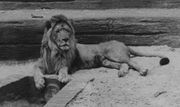Barbary Lion
2008/9 Schools Wikipedia Selection. Related subjects: Mammals
| Barbary Lion | ||||||||||||||||
|---|---|---|---|---|---|---|---|---|---|---|---|---|---|---|---|---|
 |
||||||||||||||||
| Conservation status | ||||||||||||||||
| Scientific classification | ||||||||||||||||
|
||||||||||||||||
| Trinomial name | ||||||||||||||||
| Panthera leo leo (Linnaeus, 1758) |
||||||||||||||||
| Synonyms | ||||||||||||||||
|
Panthera leo berberisca |
The Barbary Lion, Atlas lion or Nubian lion (Panthera leo leo) is a subspecies of lion that has become extinct in the wild. There are around forty in captivity in Europe, with less than a hundred in zoos around the world.
The Barbary lion formerly ranged in North Africa from Morocco to Egypt. The last known Barbary lion in the wild was shot in the Atlas Mountains in 1922. The Barbary lion was believed to be extinct in captivity as well. However, possible Barbary lion individuals or descendants have been located in zoos and circus populations within the last three decades.
The Barbary lion is often considered to be the heaviest of the lion subspecies; the calculated weight for the males is 400-600 lbs (180 to 270 kg) and females 220-400 lbs (100 to 180 kg), approximately the weight of Bengal Tigers. Many experts however believed that such weights are greatly exaggerated and the Barbary lion is perhaps similar in size to the sub-Saharan lion. However, there is no reliable reference about the real size of this subspecies.
The two other primary predators of northern Africa, the Atlas bear and Barbary Leopard, are now extinct, or close to extinction.
Barbary lions in captivity and possible surviving individuals
In the Middle Ages, the lions kept in the menagerie at the Tower of London were Barbary lions, as shown by DNA testing on the two well-preserved skulls excavated at the Tower in 1937. The skulls have been radiocarbon dated to AD 1280-1385 and AD 1420-1480. Dr Nobuyuki Yamaguchi of the Wildlife Conservation Unit at the University of Oxford said the growth of civilizations along the Nile and in Sinai Peninsula by the beginning of the second millennium BC stopped genetic flow, thereby isolating lion populations. The lion survived in the wild in northernwestern Africa in what is now current day Libya, Tunisia, Algeria and Morocco until about 100 years ago..
In the 19th century and the early 20th century Barbary lions were often kept in zoos and circus menageries. The lions in the Tower of London were transferred to more humane conditions at the London Zoo in 1835, on the orders of the Duke of Wellington. One famous purebred Barbary lion named "Sultan" lived in the London Zoo in 1896.
Another one is known from Leipzig. Currently there are several dozen individuals in captivity believed to be Barbary lions: Port Lympne Wild Animal Park has twelve specimens descended from animals owned by the King of Morocco. In addition, eleven animals believed to be Barbary lions were found in Addis Ababa zoo, descendants of animals owned by Emperor Haile Selassie.
In the past scientists believed that the distinct sub-species status of the Barbary lion was established by its seemingly fixed external morphology, particularly its heavier mane. However, it is now known that various extrinsic factors influence the colour and size of all lions' manes, such as ambient temperature. As the cooler ambient temperature in European and North American zoos has been found to produce Barbary-like manes on ordinary lions, this characteristic is now considered an inappropriate marker for identifying Barbary ancestry.
In 2005, Mitochondrial DNA research revealed that a lion specimen from Neuwied Zoo is not of sub-Saharan origin according to its mitochondrial lineage and, thus, very likely a descendant of a Barbary lion.
Despite this, Mitochondrial DNA research published in 2006 does support the distinctness of the Barbary lions as a sub-species. The results found a unique mtDNA haplotype to be present in some of those museum specimens believed to be of Barbary descent. This may be a good molecular marker for identifying -- and excluding -- other potential Barbary lions. The mtDNA results revealed that five tested samples of lions from the famous collection of the King of Morocco are not, according to this criterion, maternally Barbary.
The Barbary Lion Project
The former popularity of the Barbary Lion as a zoo animal provides the only hope to ever see it again in the wild in North Africa. After years of research into the science of the Barbary Lion and stories of surviving examples, WildLink International, in collaboration with Oxford University, launched their ambitious International Barbary Lion Project. They are using the very latest DNA techniques to identify the DNA 'fingerprint' of the Barbary Lion subspecies. WildLink International has taken bone samples from remains of Barbary Lions in museums across Europe, like those in Brussels, Paris, Turin and others. These samples are returned to Oxford University where the science team is extracting the DNA sequence that identifies the Barbary as a separate subspecies. Although the Barbary is officially extinct, WildLink International had identified a handful of lions in captivity around the world that are descended from the original Barbary Lion, like the royal lions in Temara Zoo in Rabat, Morocco. These descendants will be tested against the DNA fingerprint and the degree of any hybridisation (from crossbreeding) can then be determined. The best candidates will then enter a selective breeding programme that will ' breed back' the Barbary Lion. The final phase of the project will see the lions released into a National Park in the Atlas Mountains of Morocco. WildLink International has since become unavailable. The project is now indefinitely on hold until the funds can be raised. As recently, six Barbary lions were released to Aquila Private Game Reserve in South Africa two hours from Cape Town to restore the Cape lion.
Asiatic Lion - an Asian relative
In 1968, a study on the skulls of the Barbary, extinct Cape, Asiatic, and other African lions showed that the same skull characteristics - the very narrow postorbital bar - existed in only the Barbary and the Asiatic lion skulls. This shows that there may have been a close relationship between the lions from Northernmost Africa and Asia. It is also believed that the South European Lion that became extinct in A.D. 80-100, could have represented the connecting link between the North African and Asiatic lions. It is believed that Barbary lions possess the same belly fold (hidden under all that mane) that appears in the Asian lions today.

